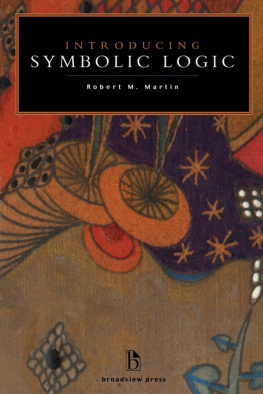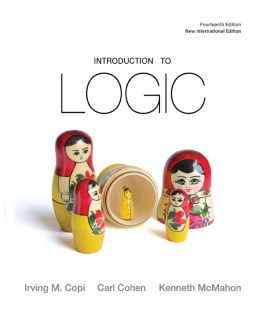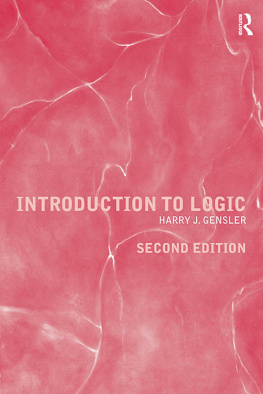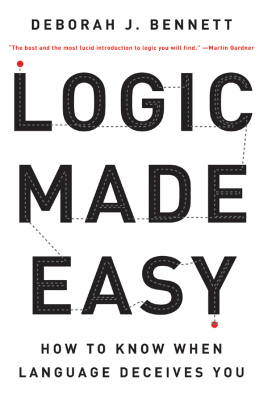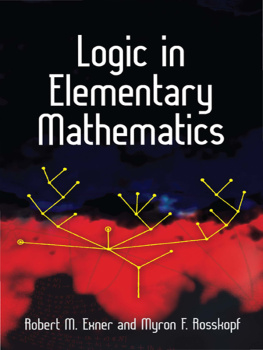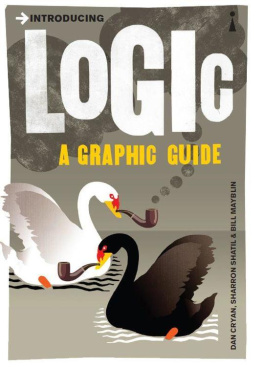PENGUIN BOOKS
Logic
Wilfrid Hodges was born in 1941 and educated at New College, Oxford (195965), where he received a first degree not only in Literae Humaniores but also in Theology. In 1970 he was awarded a doctorate for a thesis in Logic. He was a lecturer in Philosophy and later in Mathematics at Bedford College, University of London. He has held visiting appointments in the philosophy department of the University of California, Los Angeles, and the mathematics department of the University of Colorado at Boulder. He is now a Professor of Mathematics at Queen Mary and Westfield College, University of London.
Among his publications are the chapter on Elementary Predicate Logic in the Handbook of Philosophical Logic (vol. 1, 1983), three textbooks in model theory, and papers on the mathematics, history and psychology of logic in various journals and proceedings. He has given several public lectures on topics in logic, mathematics and music. He has held editorial positions on five logic journals, and he has been President of the British Logic Colloquium and the European Association for Logic, Language and Information.
WILFRID HODGES
Logic
Second Edition

PENGUIN BOOKS
PENGUIN BOOKS
Published by the Penguin Group
Penguin Books Ltd, 80 Strand, London WC2R 0RL, England
Penguin Putnam Inc., 375 Hudson Street, New York, New York 10014, USA
Penguin Books Australia Ltd, 250 Camberwell Road, Camberwell, Victoria 3124, Australia
Penguin Books Canada Ltd, 10 Alcorn Avenue, Toronto, Ontario, Canada M4V 3B2
Penguin Books India (P) Ltd, 11 Community Centre, Panchsheel Park, New Delhi 110 017, India
Penguin Books (NZ) Ltd, Cnr Rosedale and Airborne Roads, Albany, Auckland, New Zealand
Penguin Books (South Africa) (Pty) Ltd, 24 Sturdee Avenue. Rosebank 2196, South Africa
Penguin Books Ltd, Registered Offices: 80 Strand, London WC2R 0RL, England
www.penguin.com
First published in Pelican Books 1977
Reprinted in Penguin Books 1991
Second Edition published 2001
Copyright Wilfrid Hodges, 1977, 2001
All rights reserved
Except in the United States of America, this book is sold subject to the condition that it shall not, by way of trade or otherwise, be lent, re-sold, hired out, or otherwise circulated without the publishers prior consent in any form of binding or cover other than that in which it is published and without a similar condition including this condition being imposed on the subsequent purchaser
ISBN:978-0-14-192684-1
Contents
Acknowledgements
Nothing in this book is original, except perhaps by mistake. It is meant as an introduction to a well-established field of ideas; I only added a pattern and some examples. For discussions on various drafts of parts of the book, and related topics, I have many people to thank: chiefly David Wiggins, David K. Lewis, Ted Honderich, my wife Helen, and six generations of undergraduates specializing in various subjects at Bedford College. I thank Mariamne Luddington for her cheerful illustrations.
Permission to reproduce material in this book is acknowledged to the following sources:
To Pan Books Ltd for permission to quote in section 4 from Denys Parsonss collection of newspaper howlers, Funny Amusing and Funny Amazing, published in 1969.
To Harcourt Brace Jovanovich, Inc., and to Faber & Faber Ltd, for four lines from T. S. Eliots Burnt Norton, from Four Quartets.
To the Oxford University Press for lines from Spelt from Sibyls Leaves by Gerard Manley Hopkins, from the fourth edition (1967) of The Poemsof Gerard Manley Hopkins, edited by W. H. Gardner and N. H. Mackenzie, published by arrangement with the Society of Jesus.
To the Controller of Her Majestys Stationery Office for an extract from paragraph 46 of Corporal Punishment, cmnd 1213, published in I960, Crown copyright.
The extract from the Authorized Version of the Holy Bible which is copyright is used with permission.
Wilfrid Hodges
Bedford College
March 1976
Introduction
This book was written for people who want to learn some elementary logic, regardless of whether they are taking a course in it.
The book is written as a conversation between you (the reader) and me (the author). To keep the conversation from being too one-sided, I put in fairly frequent exercises. You are strongly urged to try to answer these as you reach them. Correct answers are given at the end of the book.
If you have a phobia of symbols, you should leave out the seven sections marked + in the text. These cover the branch of logic known as Formal Logic; they contain the worst of the mathematics.
English words and phrases which are being discussed are usually printed bold; most of these are listed in the index. A word is printed in quotes when we are chiefly interested in the way it occurs in some phrase.
For the second edition I rewrote sections 41 and 44 and added a few new exercises. I also corrected some typos and stupidities (and I thank the kind people who pointed these out). My special thanks to Jamal Ouhalla and Trevor Toube for helping me with linguistics and with chemical terminology respectively.
Wilfrid Hodges
Queen Mary
University of London
August 2000
Consistency
Logic can be defined as the study of consistent sets of beliefs; this will be our starting-point. Some people prefer to define logic as the study of valid arguments. Between them and us there is no real disagreement, as section 11 will show. But consistency makes an easier beginning.
1. Consistent Sets of Beliefs
Logic is about consistency but not about all types of consistency. For example, if a man supports Arsenal one day and Spurs the next, then he is fickle but not necessarily illogical. If the legal system makes divorce easy for the rich but hard and humiliating for the poor, then it is unjust but not illogical. If a woman slaps her children for telling lies, and then tells lies herself, she may be two-faced but she need not be illogical.
The type of consistency which concerns logicians is not loyalty or justice or sincerity; it is compatibility of beliefs. A set of beliefs is consistent if the beliefs are compatible with each other. To give a slightly more precise definition, which will guide us through the rest of this book: a set of beliefs is called consistent if these beliefs could all be true together in some possible situation. The set of beliefs is called inconsistent if there is no possible situation in which all the beliefs are true.
For example, suppose a man believes:
It would be wrong to censor violent programmes on television, because peoples behaviour isnt really affected by what they see on the screen. All the same it would be a good idea to have more programmes showing the good sides of our national way of life, because it would straighten out some of the people who are always knocking our country. | 1.1 |
These beliefs are inconsistent: if its really true that peoples behaviour is not affected by what they see on the television screen, then it cant also be true that critics of a country will be reformed by what they see on the television screen. There is no possible situation in which (1.1) could all be true.
Inconsistency of beliefs is not at all the same thing as stupidity or unreasonableness. Take for example the man who believes:


